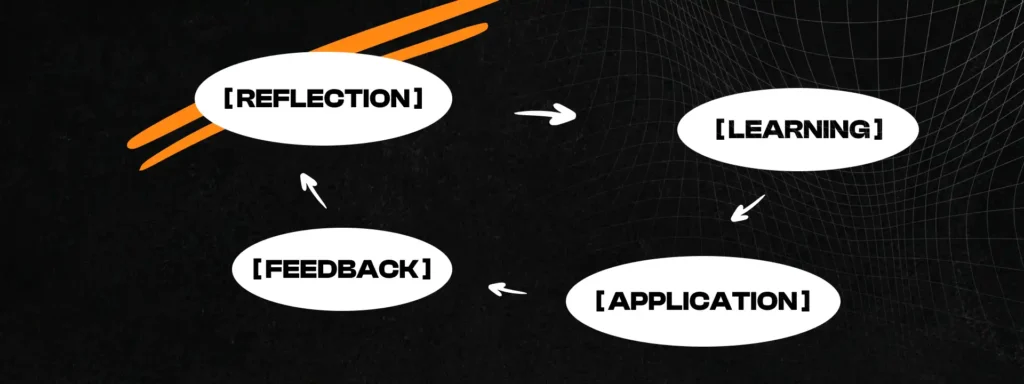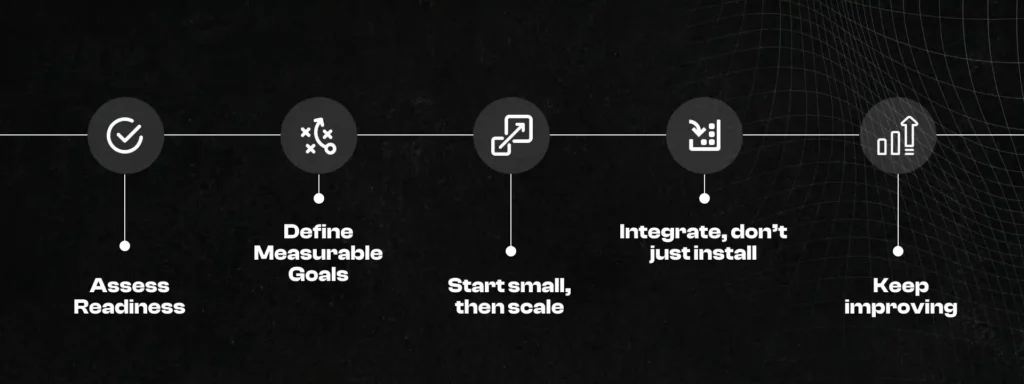Artificial Intelligence has become the new gold rush for modern businesses. From personalized shopping experiences to automated customer service, everyone wants to “add AI” to their operations. Retailers invest in chatbots, eCommerce stores integrate product recommendation engines, and marketing teams experiment with AI-generated content – all hoping to capture the next significant advantage.

However, as The GenAI Divide: State of AI in Business 2025 reveals, the reality is quite different. Despite over $30 billion invested in generative AI tools, 95% of companies fail to achieve measurable ROI. Most AI initiatives never move beyond the pilot phase – not because the technology isn’t powerful, but because it’s implemented for the wrong reasons.
The excitement around AI often leads to hype-driven decisions: “We need AI because everyone else has it.” Yet, without a clear purpose, the correct data, and a plan for integration, these projects become expensive experiments with little business impact.
In this article, we’ll explore why most AI projects don’t deliver results, how to identify when your business is truly ready for AI, and what steps you can take to integrate it strategically – not impulsively.
The Reality Check – What the Data Says
The global conversation around AI is full of success stories – but the data tells a different story. According to the State of AI in Business 2025 Report, the gap between adoption and impact has never been wider.
Despite a surge in corporate enthusiasm, only 5% of AI projects actually create measurable business value. Meanwhile, 95% of companies struggle to see a return on their investment – not because AI doesn’t work, but because it’s often applied without a clear business objective.

Let’s look at some of the key findings from the report:
- $30–40 billion was invested globally in generative AI tools in 2024–2025.
- Only one in twenty pilots moved beyond the testing phase into active workflows.
- 70% of implementations focused solely on marketing or content generation — areas easiest to start, but hardest to scale profitably.
- Companies that integrated AI into their core business operations (such as logistics, customer support, and data analytics) were three times more likely to report a tangible ROI.
The report calls this imbalance the “AI Adoption Paradox”:
“The more companies invest in AI for the sake of innovation, the less real value they often create.”
In e-commerce and retail, this paradox is particularly evident. We see brands launching “AI-powered” chatbots, recommendation engines, and marketing copy tools – only to discover later that these systems aren’t improving conversions or customer satisfaction. Why? Because technology alone doesn’t change results; integration does.
The numbers make it clear: AI itself isn’t the problem – the way it’s implemented is.
In the next section, we’ll break down the most common reasons why AI projects fail and what eCommerce businesses can learn from them before leaping.
Why Most AI Projects Fail
AI doesn’t fail – businesses do, when they treat it as a trend rather than a transformation. The State of AI in Business 2025 report makes it clear: most AI projects fail not because of poor technology, but because of inadequate implementation and unclear strategy.
Let’s look at the most common reasons why this happens — especially in the eCommerce and retail sectors.
1. No Clear Business Objective
Many companies begin with the question, “What can we do with AI?” rather than “What problem are we trying to solve?”

The result is projects that sound innovative but deliver no measurable value.
For example, an online retailer may launch an AI-powered chatbot to “look modern.” Without a clear goal, such as reducing customer service response time or lowering ticket volume, the system quickly turns into a cost center instead of a business driver.
Takeaway: Start with measurable outcomes. Define what success looks like – higher conversion rate, lower cart abandonment, faster support response – before choosing any AI tool.
2. Treating AI as an Add-on, Not a System
Many companies add AI as a separate plugin or SaaS tool, disconnected from their core data and workflows.
In eCommerce, this leads to recommendation engines that don’t match customer behavior, chatbots that can’t access order information, or marketing tools that generate irrelevant content.
AI can’t create value if it doesn’t have access to the data and context that drive your business.

Takeaway: Integration is more important than installation. AI should become part of your ecosystem, not an isolated feature.
3. No Feedback Loop or Learning Process
AI systems rely on feedback to improve accuracy and relevance. When companies skip this step, the model’s performance declines over time.
For instance, if a recommendation engine isn’t trained on updated sales data or product availability, it continues to promote irrelevant items – frustrating customers and hurting conversions.
Takeaway: Build a feedback loop from day one. Utilize data analytics, customer feedback, and performance metrics to refine the model continually.

4. Wrong Success Metrics
Another common mistake is focusing on adoption metrics rather than the business impact.
Counting the number of prompts, generated texts, or chatbot sessions doesn’t show whether AI improves revenue or efficiency.

Takeaway: Replace vanity metrics with ROI-based KPIs – such as time saved, revenue generated, or cost per automated task.
5. Hype-Driven Decision Making
Under pressure to “keep up with competitors,” many companies rush into AI projects without understanding the risks or long-term costs.
As the MLQ.ai report notes, the result is an “AI adoption paradox”: the more companies invest in AI for the sake of innovation, the less real value they often create.

Takeaway: True innovation isn’t about being first to implement AI — it’s about being the one who integrates it best.
In the next section, we’ll look at when AI does work — and what differentiates successful AI transformations from the 95% that fail to deliver measurable results.
Strategic Integration – When AI Actually Works
While many AI initiatives fail, some companies are quietly achieving remarkable results. The difference isn’t in the tools they choose – it’s in how they use them.
AI becomes a growth engine when it is intentionally integrated into business processes, supported by data, and aligned with measurable goals.
According to the Harvard Business School’s 2024 study “Navigating the Jagged Technological Frontier,” knowledge workers using AI improved the quality of their work by more than 40%. They completed tasks 25% faster than those without AI support.

But there’s an essential condition: those gains occurred only when AI was applied to tasks within its competence zone – areas where the model had enough context, structure, and reliable data to make accurate decisions.
In eCommerce and retail, this principle translates directly into real-world outcomes:
1. Customer Service with Human Oversight
AI chatbots that answer repetitive questions and escalate complex ones to human agents can reduce response times and increase customer satisfaction.
However, fully autonomous bots without escalation logic often frustrate users and damage brand perception.
Lesson: Combine automation with human review – “AI in the loop” performs best.
2. Product Recommendations Based on Real-Time Data
AI recommendation engines work only when trained on current inventory, behavioral data, and sales performance.
When properly integrated, they increase conversions and average order value; when isolated, they promote out-of-stock or irrelevant items.
Lesson: AI requires continuous data synchronization, not a one-time setup.
3. Content Generation with Clear Brand Context
AI tools can accelerate marketing production – from product descriptions to ad copy — but only when guided by defined tone, SEO rules, and review cycles.
Otherwise, they generate generic content that weakens brand identity.
Lesson: Treat AI as a creative assistant, not as your entire marketing team.
4. Predictive Analytics for Inventory and Sales
When connected to historical data, AI forecasting models can help retailers anticipate demand peaks, prevent stockouts, and optimize pricing.
However, they often fail without a data discipline or proper validation pipelines.
Lesson: Predictive AI must be tied to your operational data strategy.
In every successful case, AI is not a shiny plugin – it is a component of a well-designed system. Companies that achieve real impact understand that AI success starts with integration, not installation.
In the next section, we’ll outline a practical roadmap for integrating AI into your business processes – from assessing readiness to scaling impact strategically.
At IT Delight, we help eCommerce and retail brands integrate AI with purpose, not just for hype.
Let’s create a roadmap that delivers real results.
Building an AI Roadmap for Your Business
Integrating AI isn’t about trying the latest tool – it’s about aligning technology with business goals. Before you start, make sure you have a clear strategy that defines where AI will create real value and how success will be measured.

1. Assess readiness.
Audit your processes, data quality, and system connectivity to ensure optimal performance. If your platforms – from CRM to ERP – don’t share data effectively, AI won’t either.
2. Define measurable goals.
Decide what success means: higher conversion rates, reduced response time, or better product discovery. Tie every AI initiative to a KPI and a timeframe.
3. Start small, then scale.
Focus on one high-impact use case first, such as automated product tagging, dynamic recommendations, or intelligent support routing, and then expand from there.
4. Integrate, don’t just install.
AI must work within your ecosystem, connected to live data and workflows. Without integration, even the best model remains a siloed experiment.
5. Keep improving.
Monitor, retrain, and refine. The businesses that gain from AI treat it as an ongoing process, not a one-time project.
At IT Delight, our AI Integration Advisory Services help eCommerce and retail businesses identify where AI makes a real difference – not just where it looks trendy.
We analyze your data landscape, prioritize use cases, and create a practical roadmap that leads from experimentation to measurable ROI.
Conclusion – Purpose Over Pressure
AI is transforming how modern businesses operate, but success doesn’t come from being first – it comes from being strategic. Many companies rush into adoption, expecting instant results, only to find that technology without direction brings little value. The real competitive edge belongs to those who integrate AI with purpose – grounded in data, clear objectives, and measurable outcomes.
For eCommerce and retail brands, this means focusing on impact, not appearance. With a thoughtful roadmap and the right expertise, AI can become a tool for sustainable growth, rather than just another experiment. Contact us to discuss how our team can help you plan and integrate AI solutions that truly make a difference.
